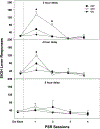Conditioned stimuli affect ethanol-seeking by female alcohol-preferring (P) rats: the role of repeated-deprivations, cue-pretreatment, and cue-temporal intervals
- PMID: 31093721
- PMCID: PMC6697605
- DOI: 10.1007/s00213-019-05264-6
Conditioned stimuli affect ethanol-seeking by female alcohol-preferring (P) rats: the role of repeated-deprivations, cue-pretreatment, and cue-temporal intervals
Abstract
Rationale: Evidence indicates that drug-paired stimuli can evoke drug-craving leading to drug-seeking and repeated relapse periods can influence drug-seeking behaviors.
Objectives: The present study examined (1) the effect of an interaction between repeated deprivation cycles and excitatory conditioning stimuli (CS+) on ethanol (EtOH)-seeking; (2) the effects of EtOH-paired cue-exposure in a non-drug-paired environment on subsequent conditioning in a drug-paired environment; and (3) the temporal effects of conditioned cues on subsequent EtOH-seeking.
Methods: Adult female alcohol-preferring (P) rats were exposed to three conditioned odor cues; CS+ associated with EtOH self-administration, CS- associated with the absence of EtOH (extinction training), and a neutral stimulus (CS0) presented in a neutral non-drug-paired environment. The rats underwent four deprivation cycles or were non-deprived, following extinction they were maintained in a home cage for an EtOH-free period, and then exposed to no cue, CS+, CS-, or CS0 to assess the effect of the conditioned cues on EtOH-seeking behavior.
Results: Repeated deprivations enhanced and prolonged the duration of CS+ effects on EtOH-seeking. Presentation of the CS- in a non-drug-paired environment blocked the ability of a CS+ to enhance EtOH-seeking in a drug-paired environment. Presentation of the CS+ or CS- in a non-drug-paired environment 2 or 4 h earlier significantly altered EtOH-seeking.
Conclusion: Results indicated an interaction between repeated deprivation cycles and CS+ resulted in a potentiation of CS+ evoked EtOH-seeking. In addition, a CS- may have therapeutic potential by providing prophylactic protection against relapse behavior in the presence of cues in the drug-using environment.
Keywords: Alcohol relapse; Alcohol-preferring (P) rats; Drug deprivation; Drug relapse; Drug-craving; Drug-seeking.
Figures







Similar articles
-
Inhibitory and excitatory alcohol-seeking cues distinct roles in behavior, neurochemistry, and mesolimbic pathway in alcohol preferring (P) rats.Drug Alcohol Depend. 2023 May 1;246:109858. doi: 10.1016/j.drugalcdep.2023.109858. Epub 2023 Mar 29. Drug Alcohol Depend. 2023. PMID: 37028106 Free PMC article.
-
Oral Conditioned Cues Can Enhance or Inhibit Ethanol (EtOH)-Seeking and EtOH-Relapse Drinking by Alcohol-Preferring (P) Rats.Alcohol Clin Exp Res. 2016 Apr;40(4):906-15. doi: 10.1111/acer.13027. Alcohol Clin Exp Res. 2016. PMID: 27038599 Free PMC article.
-
Parameters of Context-Induced Ethanol (EtOH)-Seeking in Alcohol-Preferring (P) Rats: Temporal Analysis, Effects of Repeated Deprivation, and EtOH Priming Injections.Alcohol Clin Exp Res. 2016 Oct;40(10):2229-2239. doi: 10.1111/acer.13205. Epub 2016 Sep 22. Alcohol Clin Exp Res. 2016. PMID: 27696522 Free PMC article.
-
Alcohol withdrawal and conditioning.Alcohol Clin Exp Res. 2005 Mar;29(3):453-64. doi: 10.1097/01.alc.0000156737.56425.e3. Alcohol Clin Exp Res. 2005. PMID: 15770122 Review.
-
Advances in Animal Models of Relapse for Addiction Research.In: Kuhn CM, Koob GF, editors. Advances in the Neuroscience of Addiction. Boca Raton (FL): CRC Press; 2010. Chapter 1. In: Kuhn CM, Koob GF, editors. Advances in the Neuroscience of Addiction. Boca Raton (FL): CRC Press; 2010. Chapter 1. PMID: 21656976 Free Books & Documents. Review.
Cited by
-
Negative and positive allosteric modulators of the α7 nicotinic acetylcholine receptor regulates the ability of adolescent binge alcohol exposure to enhance adult alcohol consumption.Front Behav Neurosci. 2023 Apr 4;16:954319. doi: 10.3389/fnbeh.2022.954319. eCollection 2022. Front Behav Neurosci. 2023. PMID: 37082421 Free PMC article.
-
Inhibitory and excitatory alcohol-seeking cues distinct roles in behavior, neurochemistry, and mesolimbic pathway in alcohol preferring (P) rats.Drug Alcohol Depend. 2023 May 1;246:109858. doi: 10.1016/j.drugalcdep.2023.109858. Epub 2023 Mar 29. Drug Alcohol Depend. 2023. PMID: 37028106 Free PMC article.
-
Evidence for incentive salience sensitization as a pathway to alcohol use disorder.Neurosci Biobehav Rev. 2019 Dec;107:897-926. doi: 10.1016/j.neubiorev.2019.10.009. Epub 2019 Oct 28. Neurosci Biobehav Rev. 2019. PMID: 31672617 Free PMC article. Review.
-
Multi-modal imaging reveals differential brain volumetric, biochemical, and white matter fiber responsivity to repeated intermittent ethanol vapor exposure in male and female rats.Neuropharmacology. 2020 Jun 15;170:108066. doi: 10.1016/j.neuropharm.2020.108066. Epub 2020 Mar 30. Neuropharmacology. 2020. PMID: 32240669 Free PMC article.
-
Preconceptual paternal ethanol drinking induces sexually dimorphic behavioural changes across 2 generations.Psychopharmacology (Berl). 2025 May 20. doi: 10.1007/s00213-025-06807-w. Online ahead of print. Psychopharmacology (Berl). 2025. PMID: 40389584
References
-
- Bouton ME (2004) Context and behavioral processes in extinction. Learn Mem 11:485–94 - PubMed
MeSH terms
Substances
Grants and funding
LinkOut - more resources
Full Text Sources
Medical

